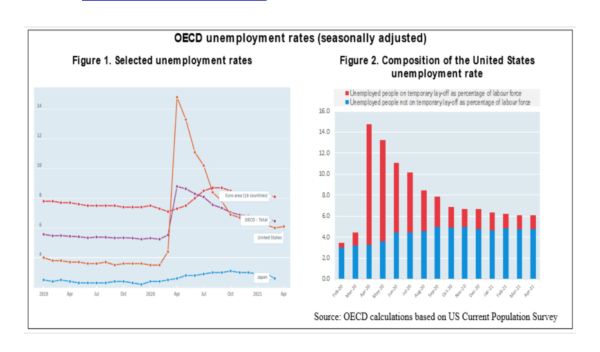Marginal Fall In OECD Unemployment Rate In March 2021, To 6.5%, 1.2 Percentage Points Above Its Pre-pandemic Level
The OECD area unemployment rate continued to decline slightly in March 2021, to 6.5% (from 6.6% in February 2021). It remained 1.2 percentage points above the rate observed in February 2020, before the COVID-19 pandemic hit the labour market.[1]
In March, a marginal decline of the unemployment rate was also observed in the euro area, (to 8.1%, from 8.2% in February 2021), where the largest falls (0.2 percentage point or more) were registered in Finland (to 7.7%), Lithuania (to 8.9%), Portugal (to 6.5%) and Spain (to 15.3%).
Outside Europe, the unemployment rate decreased in March in most countries: by 0.7 percentage point in Canada (to 7.5%), 0.5 percentage point in Colombia (to 13.8%), 0.3 percentage point in Japan (to 2.6%), and 0.2 percentage point in Australia (to 5.6%), Mexico (to 4.3%) and the United States (to 6.0%). By contrast, it rose by 0.3 percentage point, to 5.4%, in Israel. More recent data show that in April the unemployment rate rose by 0.6 percentage point in Canada (to 8.1%) and by 0.1 percentage point in the United States (to 6.1%).
The OECD youth unemployment rate (people aged 15 to 24) decreased further in March, to 13.3% (from 13.6% in February), still 2.0 percentage points above its pre-pandemic level (February 2020).
More generally, it should be noted that unemployment statistics do not account for the full amount of labour market slack due to COVID-19, as some non-employed people may be classified as “out of the labour force”, because, due to the pandemic, they are either not able to actively look for a job or are not available to work.[2]
See the full release.
See the tables and charts in Excel.



 ICHRP: ICHRP Condemns Harassment And Threats Against Victims Of Duterte’s War On The Poor
ICHRP: ICHRP Condemns Harassment And Threats Against Victims Of Duterte’s War On The Poor World Vision: 3.5 Million Displaced Following Myanmar Earthquake And Ongoing Internal Conflict
World Vision: 3.5 Million Displaced Following Myanmar Earthquake And Ongoing Internal Conflict World Butchers Challenge: World’s Top Butchers From 14 Nations Go Knife-to-Knife In Paris
World Butchers Challenge: World’s Top Butchers From 14 Nations Go Knife-to-Knife In Paris Save The Children: ‘It Was Terrifying’ - Children Prepare To Spend Myanmar New Year Festival In Shelters Following Earthquake
Save The Children: ‘It Was Terrifying’ - Children Prepare To Spend Myanmar New Year Festival In Shelters Following Earthquake Global Forest Coalition: Global NGOs Call On International Maritime Org To Reject Biofuels And Commit To Truly Clean Energy
Global Forest Coalition: Global NGOs Call On International Maritime Org To Reject Biofuels And Commit To Truly Clean Energy Australian Catholic University: Principals Navigate Growing Challenges As Anxiety, Depression Increase And Violence, Workloads Intensify
Australian Catholic University: Principals Navigate Growing Challenges As Anxiety, Depression Increase And Violence, Workloads Intensify